Bad lighting can ruin a luxury dining experience before the food even arrives. This makes your beautiful space feel cheap, turning away customers and hurting your brand's reputation.
For luxury restaurants and cafés, the best COB LED downlights have a high CRI (>90), warm color temperature (2700K-3000K), narrow beam angles (15°-24°), and excellent beam consistency (deviation ≤±5%). This combination creates a uniform, exclusive, and inviting atmosphere that makes food look incredible.
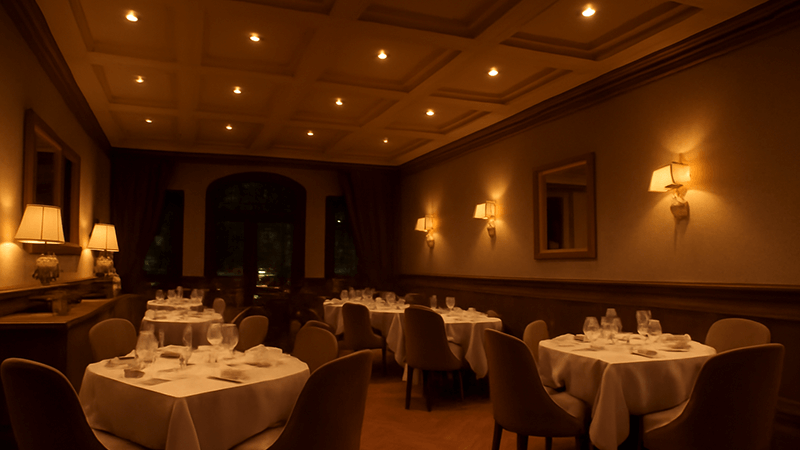
Choosing the right light is about more than just brightness. It's about crafting an experience. The wrong choice can make an expensive interior look flat, while the right one can make a simple room feel like a million dollars. So, how do you make sure you get it right for every part of your establishment?
Let's break down the specific lighting needs for different areas, from the cozy corner of a café to the demanding environment of a commercial kitchen. Understanding these details will help you create a space that not only looks stunning but also functions perfectly for your staff and guests.
What is the best lighting for a cafe?
Your cafe's lighting feels generic and uninviting. Customers don't stay long, and your unique brand identity is lost in the glare of poor illumination.
The best lighting for a cafe uses a layered approach1. You should combine warm ambient downlights (2700K-3000K), focused task lighting2 over counters and tables, and specific accent lighting3 on artwork or decor. This method creates depth, comfort, and highlights your cafe's character.
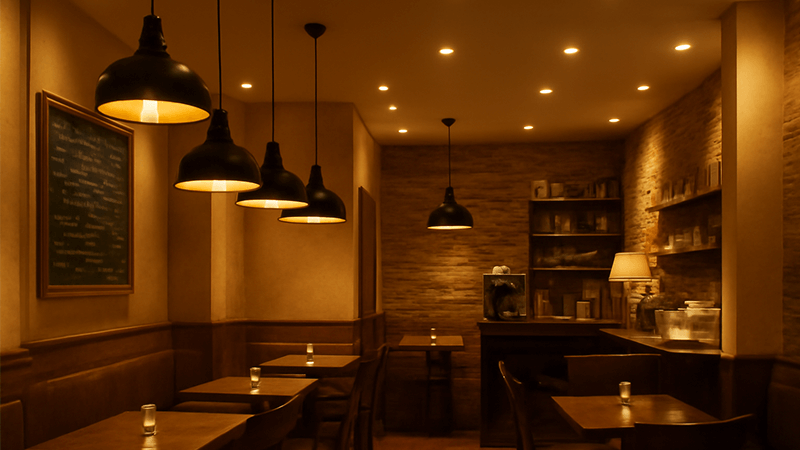
To create that perfect cafe vibe that keeps customers coming back, you need to think in layers. Lighting isn't just about one type of fixture. It’s about how different lights work together to build a mood. I have helped many clients design cafe lighting, and the most successful ones always embrace this layered strategy.
It starts with your base layer, which is ambient lighting.
Ambient Lighting: The Foundation
This is the general, overall light that fills the space and makes it comfortable to navigate. For a cozy, relaxed feel, COB LED downlights4 are an excellent choice.
- Color Temperature (CCT): You want a warm light, so stick to a CCT between 2700K and 3000K. This mimics the warm glow of evening light and makes people feel relaxed.
- Color Rendering Index (CRI): Always choose a CRI above 90. This makes your coffee, pastries, and decor look rich and appealing. A low CRI can make fresh food look dull.
- Beam Consistency: This is a technical detail that makes a huge difference. You must ensure the beam consistency5 deviation is less than or equal to ±5%. If it's more, some spots will be brighter than others, creating a messy, uneven look. Uniformity is the secret to a high-end feel.
Task and Accent Lighting: The Details
Once the ambient mood is set, you add light for specific purposes.
- Task Lighting: This is functional light placed where it's needed most. Think of stylish pendants over the service counter so your staff can work efficiently and customers can see the menu. Small, adjustable spotlights directed at each table also provide enough light for reading without disturbing the overall mood.
- Accent Lighting: This is where you add personality. Use narrow-beam track lights or spotlights to highlight artwork, a textured wall, or your menu boards. This creates visual interest and guides the customer's eye around the space.
Here is a simple table to guide you:
| Lighting Layer | Purpose | Recommended Fixture | Key Specs |
|---|---|---|---|
| Ambient | Overall illumination, sets the mood | COB LED Downlights | 2700K-3000K CCT, CRI>90, Dimmable |
| Task | Functional light for specific activities | Pendants, Adjustable Spotlights | 400-500 lumens on surface, Focused beam |
| Accent | Highlight features, create drama | Track lights, Wall washers | Narrow beam angle (10°-24°), High CRI |
What type of lighting is best for a restaurant?
Your restaurant's lighting is flat and uninspired. This fails to create an experience, making your delicious food feel less special and diners less likely to return.
The best lighting for a restaurant is dramatic and focused, using a combination of fixtures. Use dimmable, narrow-beam COB LED downlights (15°-36°) over tables to create intimate pools of light, while keeping surrounding areas darker to enhance the atmosphere.
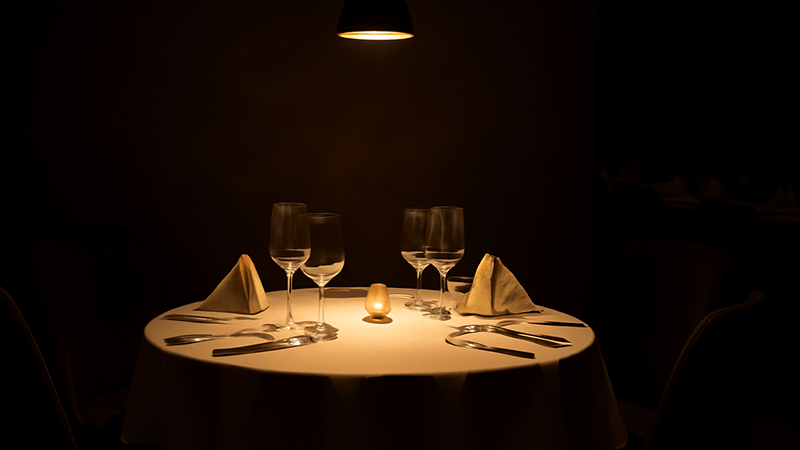
Lighting for a luxury restaurant needs to do more than just illuminate; it needs to create drama and intimacy. Unlike a bright and airy cafe, a restaurant, especially for dinner service, thrives on moodiness and focus. The goal is to make each table feel like its own private world. I once worked with a high-end steakhouse that was struggling with its atmosphere. Their lighting was too uniform, and it felt more like a cafeteria. We changed their entire approach, and it transformed the business.
Here’s how we did it, and how you can do it too.
Create Intimate "Pools of Light"
The most effective technique for restaurant dining areas is to light the tables, not the room.
- Narrow Beam Angles: Use COB LED downlights with narrow beam angles6, like 15° or 24°. Position one directly over the center of each table. This creates a crisp, focused circle of light on the tabletop, making the food and drinks the stars of the show. The areas between tables remain darker, which enhances the sense of privacy and intimacy for your guests.
- High Contrast: This high contrast7 between light and shadow is what creates a dramatic, luxurious feel. It tells your guests that this is a special place, and their experience is the focus.
Make the Food Look Irresistible
In a restaurant, the food must look as good as it tastes.
- Exceptional CRI: A CRI of over 90 is the minimum. For a luxury setting, I always recommend a CRI of 95 or even 97. More importantly, look at the R9 value8, which measures how well a light renders deep reds. A high R9 value makes meats look richer and vegetables look fresher. It’s a small detail that has a massive impact on perceived food quality.
- Warm Color Temperature: Just like in a cafe, a warm CCT of 2700K is ideal for a dining setting. It’s flattering to skin tones and creates a comfortable, welcoming environment.
Control the Mood with Dimming
A restaurant's lighting needs change throughout the day.
- Versatility: You may want brighter light for lunch service or cleaning, but a much dimmer, more romantic setting for dinner. A high-quality dimming system is not optional; it’s essential.
- Flicker-Free Performance: Ensure your downlights and drivers are capable of dimming smoothly down to 1% without any flicker. Flicker can be distracting and can even cause discomfort for some guests, completely ruining the luxury experience.
Here’s a breakdown for different restaurant areas:
| Restaurant Area | Goal | Recommended Lighting | Key Specs |
|---|---|---|---|
| Dining Tables | Intimacy, Focus on food | Narrow-beam COB Downlight | CRI>95, 2700K, 15°-24° beam, Dimmable |
| Bar | Energy, Showcase bottles | Linear LEDs, Pendants | 2700K-3000K, High CRI, Dimmable |
| Walkways | Safety, Ambiance | Low-level wall lights, Recessed floor lights | Low lumen, Warm CCT |
What type of lighting is best for a commercial kitchen?
Poor kitchen lighting is a serious safety hazard. It can lead to costly mistakes, slow down your service, and even cause accidents or hygiene issues for your staff.
For a commercial kitchen, the best lighting is bright, uniform, and durable. Use high-lumen, flicker-free LED panels or linear fixtures with a cool color temperature9 (4000K-5000K) and a CRI above 80. Fixtures must also be IP-rated for moisture and easy to clean.
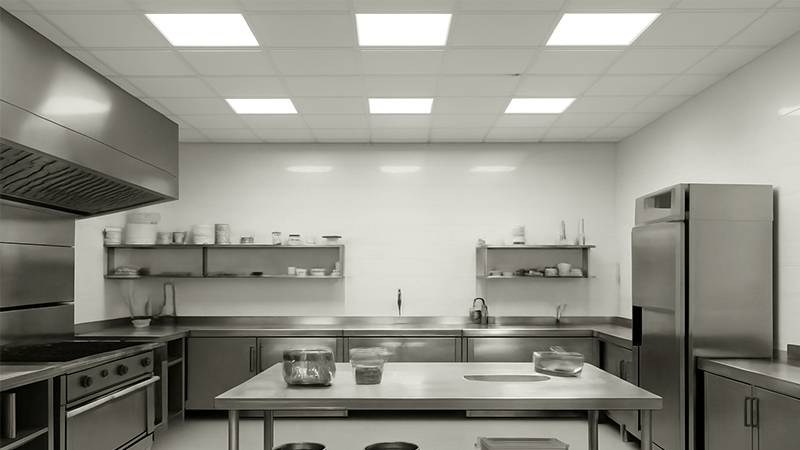
When we move from the front of the house to the back of the house, our priorities for lighting change completely. In the kitchen, ambiance and mood are irrelevant. Here, safety, functionality, and hygiene are the only things that matter. As a manufacturer, I know that designing a light for a kitchen is an engineering challenge. The fixture has to survive heat, grease, and constant cleaning while providing perfect visibility for the fast-paced work of a chef.
Let's break down the essential requirements for kitchen lighting.
Brightness and Uniformity for Safety
The number one priority is providing clear, consistent light for the kitchen staff.
- High Lux Levels: Kitchen work surfaces require high levels of illumination, typically between 500 and 1,000 lux10. This high brightness level ensures that chefs can clearly see what they are doing, which is critical for food safety and preventing accidents with knives or hot equipment.
- Eliminate Shadows: Use fixtures that provide broad, even light, like LED panels or linear strips. Shadows can hide spills on the floor, creating slip hazards, or make precise knife work difficult. Good lighting design ensures every corner and surface is well-lit.
- Cool Color Temperature: Unlike the warm tones of the dining room, a cooler color temperature of 4000K to 5000K is best for kitchens. This type of light promotes alertness and concentration, helping staff stay focused and efficient during a busy service.
Durability and Hygiene are Non-Negotiable
A kitchen is a harsh environment, and the lighting must be built to withstand it.
- IP Rating: Fixtures should have an IP65 rating or higher. This means they are completely sealed against dust and can be washed down with low-pressure water jets, which is essential for maintaining hygiene.
- NSF Certification: For kitchens in many regions, lighting fixtures must have an NSF certification11. This guarantees that the fixture is designed to be easily cleaned and does not have any crevices where bacteria can grow.
- Durable Materials: Look for fixtures made from corrosion-resistant materials like aluminum and with shatter-proof polycarbonate lenses. They must be able to handle heat, steam, and grease without degrading.
| Factor | Requirement | Why it Matters | Recommended Spec |
|---|---|---|---|
| Brightness | High & Uniform | Reduces kitchen errors and prevents accidents by eliminating shadows | 500-1000 lux on work surfaces |
| Color Temp (CCT) | Cool White | Promotes alertness and provides better visibility for tasks | 4000K - 5000K |
| Durability | Heat & Moisture Resistant | Ensures longevity and safety in a harsh environment | IP65 rating, NSF certification |
| Color Rendering (CRI) | Good Accuracy | Allows chefs to accurately judge food quality and doneness | CRI > 80 |
How many lumens for a restaurant?
You're confused by technical terms like lumens12, lux, and watts. Buying the wrong brightness can leave your restaurant either blindingly bright or dangerously dark, wasting money and effort.
There is no single lumen answer for an entire restaurant. It depends entirely on the zone. Aim for 100-200 lux for ambient dining areas, 300-500 lux directly on tables, and 500-1000 lux in kitchens. Focus on the lux target for each area.
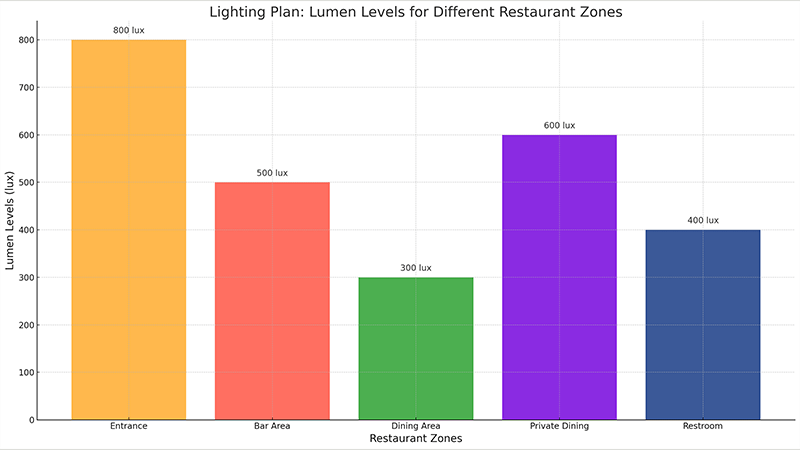
When purchasing managers like Shaz ask me, "How many lumens do I need?", my answer is always the same: "It depends on where." Thinking about the total lumens of a single bulb is the wrong approach. You need to think about the amount of light that actually lands on a surface. This measurement is called lux (lumens per square meter). A lighting plan should always be based on target lux levels for different zones, not just the lumen output of the bulbs.
Let me simplify this with a clear, zoned approach. This is the exact method professionals use to design lighting for world-class restaurants.
Understanding the Key Zones
A restaurant has many different areas, and each has a unique lighting requirement. A single-lumen value will not work. You need a detailed plan.
- Dining Areas (Ambient vs. Task): The general ambient light in the dining room can be quite low (50-100 lux) to create a moody atmosphere. However, the light directly on the table surface (the task area) needs to be much brighter (300-500 lux) so guests can read the menu and see their food clearly. A single, well-aimed 800-lumen downlight can easily achieve this on a two-person table.
- Bar: The bar is a more social, energetic space. You'll want slightly higher ambient light here (200-400 lux) to encourage interaction and to highlight the display of bottles.
- Walkways and Restrooms: Safety and comfort are key here. Walkways need enough light to be safe (50-100 lux), often from low-level wall lights. Restrooms should feel clean and comfortable, requiring brighter light than the dining room (150-200 lux).
- Kitchen and Back of House: As we discussed, this is a purely functional zone. Brightness is critical for safety and efficiency, requiring the highest lux levels in the entire establishment (500-1000 lux).
Here is a detailed table that a purchasing manager can use as a guide when creating a lighting specification sheet.
| Restaurant Zone | Ambiance Goal | Recommended Lux (lumens/m²) | Example Fixture Output |
|---|---|---|---|
| Front of House | |||
| Main Dining (Ambient) | Moody, Intimate | 50 - 100 lux | Low-output downlights |
| On the Dining Table | Focus, Task | 300 - 500 lux | One 800lm downlight with narrow beam |
| Bar Area | Social, Vibrant | 200 - 400 lux | Mix of pendants and spotlights |
| Hallways/Walkways | Safe, Transitional | 50 - 100 lux | Low-level wall sconces |
| Back of House | |||
| Kitchen Prep Areas | Bright, Safe, Task | 500 - 750 lux | High-output linear LEDs |
| Cooking/Stove Line | Very Bright, Focused | 750 - 1000 lux | Waterproof LED panels |
For any large-scale project, I always advise my clients to request a lighting simulation13 (like a DIALux report) from their supplier to verify that these target lux levels will be met before they place a big order.
Conclusion
Choosing the right COB downlights with high CRI14, correct color temperature, and consistent beams is key. Focus on a layered, zoned approach to create the perfect atmosphere for your guests.
Explore the benefits of a layered lighting strategy for enhancing cafe ambiance. ↩
Discover the importance of task lighting for functionality in dining areas. ↩
See how accent lighting can highlight features and create visual interest. ↩
Explore how COB LED downlights can enhance the ambiance and appeal of your restaurant. ↩
Find out how beam consistency impacts the overall lighting quality in restaurants. ↩
Understand how narrow beam angles can create intimate lighting for dining tables. ↩
Learn how high contrast can create a dramatic and luxurious dining atmosphere. ↩
Discover how R9 value affects the appearance of food in restaurants. ↩
Learn how cool color temperatures enhance focus and alertness in kitchens. ↩
Explore how lux measurements help in designing effective lighting plans. ↩
Understand the importance of NSF certification for food safety in kitchens. ↩
Understand the role of lumens in achieving the right brightness for different areas. ↩
Learn how lighting simulations can help ensure optimal lighting design before installation. ↩
Learn why a high Color Rendering Index is crucial for making food look appetizing. ↩

